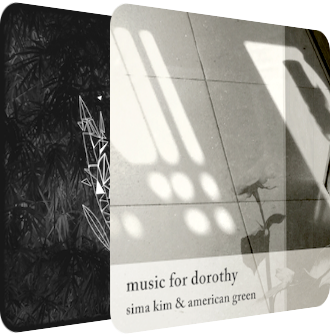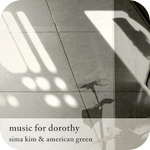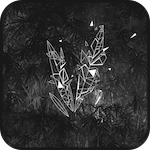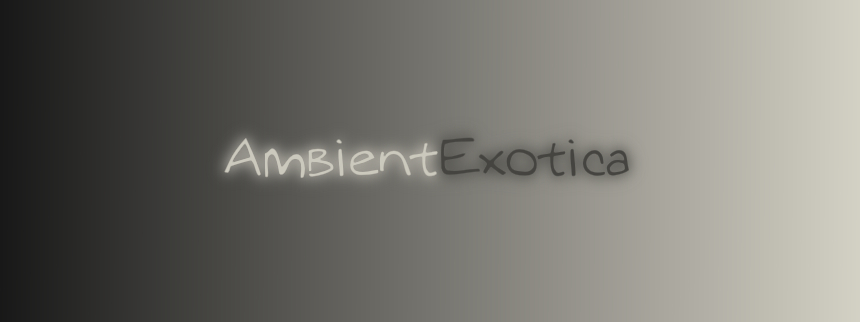
Sima Kim & American Green
Dorothy / Debris
2013
This article is one of my rare double reviews in which I am contrasting antagonistic forces. A year or two ago, I would have never imagined to have South Korean musicologist and composer Sima Kim featured in this category, but this is clearly the case here in this piece which is all about Music For Dorothy (stuk Label, Japan, September 2013) and Debris (Soft Corridor Records, Belgium, December 2013). The first album is a six-track Dream Pop-influenced exposition on tape, starring various guest musicians/vocalists, with all of the tracks co-written with Sima Kim's friend, guitarist and electronic fiddler from Fukuoka, Japan who uses the moniker American Green. That kind of green is indeed a standardized, internationally recognized turquoise-fir blending which emits the artist's jocund and convivial way of seeing the world. This turns out to be a most applicable viewpoint on Music For Dorothy, although the first prospect does not look overly promising if one analyzes the album in a playfully sarcastic way. How much music has been written about love, romance and the first date? While you are reading this sentence, bedroom producers are busily producing these, and high-posh polished glitz arrangements are churned out like crazy. Sima Kim's and American Green's shelter is the antidote, an alternative draft, unsurprisingly fueled by the Asia-Pacific school of transfiguring the initial signs of love, namely the aforementioned first date, the beating hearts, the blissful feelings of elation. All these things, in an uncanny turn of events, are amiss in Debris, oh boy! Arriving in the shape of 100 CD's with letterpressed covers, this humiliating seven-track conundrum sees Sima Kim collecting experimental pieces of droning electronics. On top of that, the musicologist visits genres which could not have been possibly linked to him heretofore, among them one devastating Hauntology cavity! Sharp contrasts, murkiness and desolateness reign in Debris, making it the foe to the cotton candy-wrapped Music For Dorothy and its municipal flair. Here is a meticulous look at each work, followed by a weighing conclusion.
At The First Meeting is the gateway to Sima Kim & American Green's pastel-colored project. Launching ever-cautiously with the pseudo-pristine large-grained haze of the aurally visualized tape recorder before moving over to stereo-panned robotic bleeps in tandem with both a rustic square lead pad and guitar twangs hued in warm orange tones, the Dream Pop/Drone hybrid downright explodes after 90 seconds. From this point onwards, euphony sets in, saturating the timbres and making room for the least bit of well-controlled chintziness. Singer Linda Ong aspirates three-note movements into the microphone while she is being accompanied by aquatic bubbles, glockenspiel prongs and a designedly muffled yet languorous breakbeat. The production values are decidedly lo-fi, a fuzzy veil covers the arrangement, true, but the glistening blebs are not affected by it, towering above the caring mélange which is rounded off with hymnic rain pad patterns at the end. Taking the felicitousness into account, this first date of seven minutes got to be a great success. The following Wisdom Tooth is another gem, spawning multifaceted as well as softened stylophone formations whose distantly pentatonic circles form the base for – you wouldn't have called for them – smarmy pizzicato strings. Normally, kitsch should ooze out of the speakers, or worse, the headphones, but the Korean-Japanese composing force hits the right tones with every texture and by means of Lux & Miro's helping hands; be it Sima Kim's rotatory accompaniment on the piano, the erupting cymbals or the pointillistic glockenspiels, every stratum adds to the parallax nature, fills the interstitial gaps that are left by each respective device. Legato shapes put the finishing touches onto another anthemic Dream Pop artifact. After all, a wisdom tooth is no sawtooth.
decidedly lo-fi, a fuzzy veil covers the arrangement, true, but the glistening blebs are not affected by it, towering above the caring mélange which is rounded off with hymnic rain pad patterns at the end. Taking the felicitousness into account, this first date of seven minutes got to be a great success. The following Wisdom Tooth is another gem, spawning multifaceted as well as softened stylophone formations whose distantly pentatonic circles form the base for – you wouldn't have called for them – smarmy pizzicato strings. Normally, kitsch should ooze out of the speakers, or worse, the headphones, but the Korean-Japanese composing force hits the right tones with every texture and by means of Lux & Miro's helping hands; be it Sima Kim's rotatory accompaniment on the piano, the erupting cymbals or the pointillistic glockenspiels, every stratum adds to the parallax nature, fills the interstitial gaps that are left by each respective device. Legato shapes put the finishing touches onto another anthemic Dream Pop artifact. After all, a wisdom tooth is no sawtooth.
Can I Come By Tonight is the third track, fittingly hued in nocturnal colors. The glockenspiel is exchanged with silkened music box loops, whereas the feisty synth streams are replaced by mauve-tinted runlets. A breakbeat scheme with vesiculating blips then serves as the backdrop for Masato Abe's nasal-narcotic vocals about mellow night lights. Curiously enough, Abe's performance is streamlined yet precisely focused and upfront. Not a classic Pop song per se, one element must not be amiss, and Sima Kim & American Green make sure to admix it near the end: the multiplication of Masato Abe's vocals until the state of a transcendental choir is reached. Add a suave swell of increasingly hymnic synths to the scenery, and you've got the archetypical climax. The following Morning Song offers a particularly enchanting setting right from the get-go, with a consistent haze of whitewashed flute-like patterns and nebular movements. This diorama then obeys to the endemics that are all over Music For Dorothy: gently arpeggiated pulses, laser sounds, swooshing winds and the vitreous-ligneous duality of simulated tonewoods. A rattling but orderly snare drum trifecta grows within these boundaries and becomes entangled with the mounting rhizomes of conviviality and – gasp – a straight 4/4 beat. In the end, the formerly pink morning is now gloriously awash with sunlight, and then some! A fleeting visit to nightly surroundings is appointed afterwards: Night Train features a laid-back downbeat structure, is coated in a crystalline cue state and features the vocals of Asa which are as hauntingly fragile as they are beautifully reverberated. Deep bass ameliorations, jagged Space-Age snarls and a whole battery of polar lights makes Night Train the most festive composition of the album, a wondrously glassy glitzscape. She Is Dorothy then functions as the final track: glacial piano spikes meet their reversely played foils as well as a velvet midrange aorta, making this beat-accentuated instrumental a particularly magical one. The duo refrains from using transparent structures like verses or bridges and rather feels out the different motions and segues, allowing the patterns room to breathe in quasi-freedom. No corset is attached, no form injected that follows – or demands – function. She Is Dorothy is a gleefully dizzy and effete piece.
Now it's time to drift into the apocacryptical album of darkness. While Debris starts – again most fittingly so – with Debris #1, the first eponymous installment out of an overall four, I would rather like to dedicate the following paragraph to these Debris shards and collect all the other title tracks in this section. Viewed from this perspective, patterns emerge. Sima Kim's darkest affair comprises of an old favorite of mine, the gorgeous Night Flight featuring Heidi Harris. The original version was an instrumental and spawned cavalcades of purple synth serpentines. The new version startles with a pressing frenzy of whispering voices, an abyssal piano fundament as well as heavily echoey argentine vaults. The air of that dungeon is filled with mephitic gases and complemental cloudlets. Indeed, one has not heard a similar Sima Kim production before. Post-processing and cavernous effects are the columns on this crestfallen but intriguingly bustling piece of… Hauntology! The formerly aeriform trip  over megacities that is suggested in the unreleased instrumental version now takes place underground, fueled by scourging eruptions, metallic surfaces and Harris' bewailing ecclesiasticism. This is an experiment if there ever was one, a dark, brooding peg o' horror. Like a monster, the transmutation has turned a formerly wraithlike ethereality into a shocking reality. Where I Was With You is similarly monstrous, but only if one considers its length of over 20 minutes which leads back to Sima Kim's point of origin in Songs (Twice Removed, 2012), but rather takes its liquid backdrops and moulds them into a Drone piece par excellence, marrying elasticized vibraphone-evoking streams of consciousness with softly glinting dots and flecks, all of them gyrating around the solemn fluxion. Minimal yet multilayered, Where I Was With You feels like a mirage awash with light, its epithelium completely translucent, slowly tiding and breathing. A most streamlined approach, very churchly and only intent to serve its own purpose. If a listener is nearby, all the better! The half-vernal May then keeps the artist's preferred Dream Pop skeleton and injects fusions of chimes, music boxes and acoustic guitar vestiges before a crimson copse. The guitar emanates Sima Kim's preferred tonality of contemplation and bliss, but the droning rivulets serve as counterparts, swallowing much of the rurality in technicolor, and intendedly so. Here, the two layers may be synchronous, but poignantly incompatible, living up to the experimental state of Debris by worshipping a state of cleavage.
over megacities that is suggested in the unreleased instrumental version now takes place underground, fueled by scourging eruptions, metallic surfaces and Harris' bewailing ecclesiasticism. This is an experiment if there ever was one, a dark, brooding peg o' horror. Like a monster, the transmutation has turned a formerly wraithlike ethereality into a shocking reality. Where I Was With You is similarly monstrous, but only if one considers its length of over 20 minutes which leads back to Sima Kim's point of origin in Songs (Twice Removed, 2012), but rather takes its liquid backdrops and moulds them into a Drone piece par excellence, marrying elasticized vibraphone-evoking streams of consciousness with softly glinting dots and flecks, all of them gyrating around the solemn fluxion. Minimal yet multilayered, Where I Was With You feels like a mirage awash with light, its epithelium completely translucent, slowly tiding and breathing. A most streamlined approach, very churchly and only intent to serve its own purpose. If a listener is nearby, all the better! The half-vernal May then keeps the artist's preferred Dream Pop skeleton and injects fusions of chimes, music boxes and acoustic guitar vestiges before a crimson copse. The guitar emanates Sima Kim's preferred tonality of contemplation and bliss, but the droning rivulets serve as counterparts, swallowing much of the rurality in technicolor, and intendedly so. Here, the two layers may be synchronous, but poignantly incompatible, living up to the experimental state of Debris by worshipping a state of cleavage.
Now to the Debris suite, the sinews, nuts and bolts of Sima Kim's album. Debris #1 launches the panopticon with 8-bit sine buzzes that send shivers down anyone's spine. Resembling the wizardry of the C64's legendary soundchip, this short opener eventually unites euphony with a xyresic asbestus coating. This is a bone-dry affair, depicting a gruesome state of decay or, well, debris, and kudos to Jess Pauwels' edged-hastate botanic artwork which visualizes the pith of monochrome nothingness most excellently. Debris #2, meanwhile, takes the afore-remarked pith to new lows. Less dry and unexpectedly hygroscopic, the piece's simplicity is based on two distinct ingredients: a three-note melody of moist rain pad drops on the one hand, and an emaciated organ rinse on the other, the latter of which successfully covers the pitch-black background… by transforming it into charcoal gray. Light there is none, but a certain warmth is able to infiltrate the wastelands. Whereas Debris #1 and #2 could well have been entered our contemporary times through a wormhole from the 50's, Debris #3 is much more sophisticated and – finally, one might say – a victim of luminosity and incandescence. Barely crossing the two-minute mark, this Drone vignette celebrates the echopraxia of Sima Kim & American Green's chord progression and acoustic colors. Like a parable with a clearly marked starting point, a celestial climax and coercible detumescence, Debris #3 encapsulates headway, movement and grace and could, paradoxically enough, be considered a failure in the artists self-imposed context of experimentalism. A beautiful piece, one which feels de trop, but ever-strong. Debris #4, the actual finale, then soaks in the same patterns of blur and light, presenting the Cologne Pop Ambient formula in a slick way. Mountainous and tramontane, the Korean artist sits on his bosky perch and watches a strikingly organic and golden shimmering panorama unfold before the inner eye. This is a twofold end: of the prickly-austere soundscapes, and the album itself.
Both albums can be considered as entirely different instances or incidents. While Music For Dorothy and Debris are both intriguing and flawlessly produced, the listener probably cannot love them equally. In terms of Sima Kim & American Green's Music For Dorothy, the following should be said: whoever the girl called Dorothy really is – Sima Kim says she is his muse, American Green declines to comment – it can be taken for granted that she must very proud of this piece of devotion. It seems as if the already Pop- and harmony-absorbing compositions by Sima Kim are adamantly driven by American Green into even warmer and more felicitous climes. Both composers support each other's ideas and carve them out, a fact that is mirrored in the aforementioned parallax movements in Music For Dorothy where a lacunar structure becomes eventually filled with equilibrated, coeval actions and reactions of the circulating kind. I can only view this release through Occidental glasses, but the intendedly sugar-sweet chords and sequences enshrine hope, the aura of a youthful life and, most importantly so, root in the J-Pop formula that is so wonderfully peculiar. Colorful, bucolic and countrified, Music For Dorothy is life seen through a cautiously sepia-toned filter, extenuating the candy colors and vivacious pipe dreams by emphasizing the aureate scaffold. How hellacious and flagrant an antagonist Debris turns out to be! No black-and-white territory per se, its existence is torn (torn apart?) by contrastive forces: dark sawtooth-shaped drones meet light polka dot chimes, elysian currents face ferocious downfalls in the musicologist's most enigmatic compositions, and glints of confidence are buried under detritus and silt. Music For Dorothy is important as a formidably conceptualized coalition of writers which Sima Kim tends to embrace only on a per-song basis, not on a whole album; likewise, Debris is equally important in terms of its malevolence and remnants of beauty in its clefts. Given the opposite directions of both releases, Sima Kim can – and probably will – venture into any direction. And since American Green and Sima Kim are friends, these songs won't be their last audio alliance.
Further listening and reading:
- You can purchase and stream Music For Dorothy and Debris at Bandcamp. This link leads to Music For Dorothy, the other one to Debris.
- Twitter galore: @sima_kim, @_AMEGRE, @stuklabel, @Ju_SoftCorridor.
Ambient Review 300: Sima Kim & American Green – Dorothy / Debris (2013). Originally published on Jan. 1, 2014 at AmbientExotica.com.
